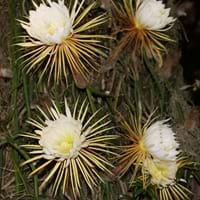Life Span
Perennial
Perennial
Type
Shrub
Cactus, Flowering Plants
Origin
North America, United States, Northeastern United States, Mid-Atlantic United States, Southeastern United States, North-Central United States, South-Central United States, Texas
South America, Argentina, Brazil
Types
not available
Not available
Habitat
Boggy areas, Fens, Fields, meadows, Swamps, Woodlands
Dry Forest, limestone outcrops, Subtropical climates
USDA Hardiness Zone
4-9
10-14
Sunset Zone
1a, 1b, 2a, 2b, 3a, 3b, 4, 5, 6, 7
H2, 13, 16, 17, 21, 22, 23, 24
Habit
Thicket/Colonizing
Upright/Erect
Flower Color
Not Available
White, Light Green
Flower Color Modifier
Not Available
Bicolor
Fruit Color
Red
Orange, Pink, White, Yellow
Leaf Color in Spring
Not Available
Not Available
Leaf Color in Summer
Not Available
Not Available
Leaf Color in Fall
Not Available
Not Available
Leaf Color in Winter
Not Available
Not Available
Leaf Shape
Oblovate
Not Available
Plant Season
Spring, Fall, Winter
Spring, Summer, Fall, Winter
Sunlight
Full Sun, Partial Sun
Full Sun
Type of Soil
Clay, Loam
Loam, Sand
The pH of Soil
Acidic, Neutral, Alkaline
Acidic, Neutral, Alkaline
Soil Drainage
Average
Well drained
Bloom Time
Late Spring
Late Spring, Early Summer
Tolerances
Not Available
Drought, Salt
Where to Plant?
Ground, Pot
Container, Ground
How to Plant?
Divison, Seedlings
Cuttings
Plant Maintenance
Medium
Medium
Watering Requirements
Keep the ground moist but not water-logged
Average Water Needs, Distilled Water, Needs good drainage
In Summer
Lots of watering
Lots of watering
In Spring
Moderate
Moderate
In Winter
Average Water
Average Water
Soil pH
Acidic, Neutral, Alkaline
Acidic, Neutral, Alkaline
Soil Type
Clay, Loam
Loam, Sand
Soil Drainage Capacity
Average
Well drained
Sun Exposure
Full Sun, Partial Sun
Full Sun
Pruning
Prune after flowering, Prune in early spring, Remove damaged leaves, Remove dead branches, Remove dead leaves
Remove damaged leaves, Remove dead branches, Remove dead leaves
Fertilizers
All-Purpose Liquid Fertilizer, Compost, Fertilize every year, Mulch, Nitrogen
All-Purpose Liquid Fertilizer
Pests and Diseases
Aphids, Apple Maggot, Fall Webworm, Red blotch, Scale
Bacterial Stem Rot, Mealy bugs, Red spider mite, Scale
Plant Tolerance
Not Available
Drought
Flower Petal Number
Not Available
Semi-Double
Foliage Texture
Not Available
Bold
Foliage Sheen
Not Available
Not Available
Attracts
Birds
Birds, Spider Mites
Allergy
Not Available
Avoid during Pregnancy, hallucinations
Aesthetic Uses
Showy Purposes
Showy Purposes
Beauty Benefits
Not Available
Not Available
Environmental Uses
Air purification
Air purification
Medicinal Uses
Not Available
Antidiabetic, Rheumatism, Soothing and relieving pain
Part of Plant Used
Fruits
Flowers, Leaves
Other Uses
Used As Food, Used as Ornamental plant
Traditional medicine, Used for its medicinal properties, Used in herbal medicines
Used As Indoor Plant
No
Yes
Used As Outdoor Plant
Yes
Yes
Garden Design
Cutflower, Mixed Border, Screening, Wind Break
Container, Edible, Hedges, Houseplant, Rock Garden, Wall, Tropical
Botanical Name
ARONIA arbutifolia
Selenicereus grandiflorus
Common Name
Red Chokeberry
Queen of the night, large-flowered cactus, sweet-scented cactus, vanilla cactus
In Hindi
लाल Chokeberry
रात की रानी
In German
Rote Apfelbeere
Königin der Nacht
In French
Red Chokeberry
Reine de la nuit
In Spanish
rojo Chokeberry
Reina de la noche
In Greek
κόκκινο Chokeberry
Βασίλισσα της νύχτας
In Portuguese
Red Chokeberry
Rainha da noite
In Polish
Red aronii
Królowa nocy
In Latin
arbutifolia
Domina noctis
Phylum
Magnoliophyta
Magnoliophyta
Class
Magnoliopsida
Magnoliopsida
Order
Rosales
Caryophyllales
Family
Rosaceae
Cactaceae
Genus
Aronia
Selenicereus
Clade
Angiosperms, Eudicots, Rosids
Angiosperms, Core eudicots, Eudicots
Tribe
Not Available
Hylocereeae
Subfamily
Not Available
Cactoideae
Number of Species
Not Available
Season and Care of Red Chokeberry and Queen of the Night
Season and care of Red Chokeberry and Queen of the Night is important to know. While considering everything about Red Chokeberry and Queen of the Night Care, growing season is an essential factor. Red Chokeberry season is Spring, Fall and Winter and Queen of the Night season is Spring, Fall and Winter. The type of soil for Red Chokeberry is Clay, Loam and for Queen of the Night is Loam, Sand while the PH of soil for Red Chokeberry is Acidic, Neutral, Alkaline and for Queen of the Night is Acidic, Neutral, Alkaline.
Red Chokeberry and Queen of the Night Physical Information
Red Chokeberry and Queen of the Night physical information is very important for comparison. Red Chokeberry height is 180.00 cm and width 12.70 cm whereas Queen of the Night height is 300.00 cm and width 90.00 cm. The color specification of Red Chokeberry and Queen of the Night are as follows:
Red Chokeberry flower color: Not Available
Red Chokeberry leaf color: Not Available
Queen of the Night flower color: White and Light Green
- Queen of the Night leaf color: Not Available
Care of Red Chokeberry and Queen of the Night
Care of Red Chokeberry and Queen of the Night include pruning, fertilizers, watering etc. Red Chokeberry pruning is done Prune after flowering, Prune in early spring, Remove damaged leaves, Remove dead branches and Remove dead leaves and Queen of the Night pruning is done Remove damaged leaves, Remove dead branches and Remove dead leaves. In summer Red Chokeberry needs Lots of watering and in winter, it needs Average Water. Whereas, in summer Queen of the Night needs Lots of watering and in winter, it needs Average Water.





